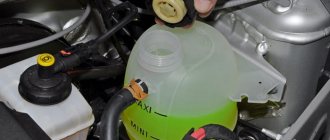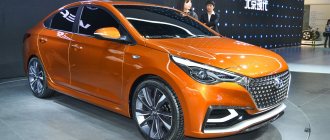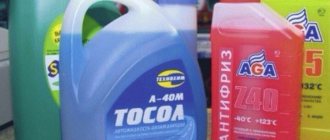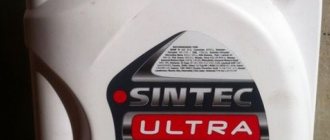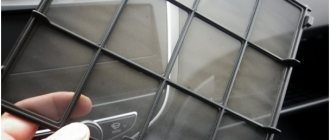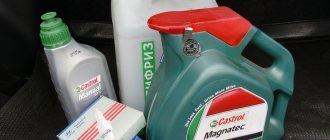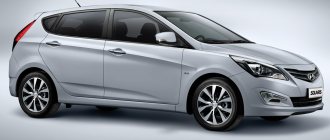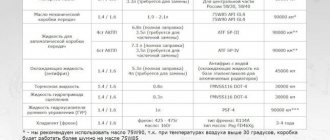When to change antifreeze in Solaris?
Factory recommendation: First replacement 210 thousand km or 120 months. Then every 30 thousand km or 24 months.
Our recommendation is slightly different: If you plan to drive after 200 thousand km and, if possible, avoid problems with the pump, then it is advisable to replace the fluid earlier. Why? Let's figure it out.
- In the manual, the resource is considered in time and mileage. If there are no questions by time, then the mileage figure needs clarification. When the car is mainly driven on the highway, without being in city traffic jams, you can focus on mileage, but usually the opposite is true. In this case, the engine operating time - engine hours - increases significantly and by 200 thousand km the antifreeze already loses a significant part of its properties. It is necessary to take into account that in traffic jams the coolant temperature is higher than on the highway. The difference is almost 10 degrees. You can notice how often the radiator cooling fan comes on during hot weather. Sometimes it works almost non-stop. All this negatively affects the life of the liquid.
- As for the entry in the manual: Then every 30,000 km or 24 months. The entry is strange and only valid if the cheapest coolants are used. If you use high-quality products, such a recommendation will not be correct. The timing and periods of replacement can be significantly extended.
- Another point that is also important is the cleanliness of the radiators. This does not mean inside, but outside - the radiator honeycombs themselves. We have two radiators in front. First the air conditioner radiator, then the main one. If they are clogged, this also affects the operating temperature of the fluid, and therefore its service life.
The bottom of the radiator is clogged with dirt
- Check whether you have radiator protection and in what condition it is. Small plastic part under the bumper.
Without it, radiators clog much faster.
The most popular engine for Hyundai Solaris
Gamma engines divide this line almost in half, but still, the G4FC engine “withstood” a little more configurations. They are very similar to each other. The FC engine was “increased” in displacement from 1396 to 1591 cubic centimeters, increasing the free stroke of the piston. The year of birth of the unit is 2007. The assembly place is the Hyundai automobile plant in the capital of China, Beijing.
Inline four-cylinder fuel-injected engine producing 123 hp. designed to meet Euro 4 and 5 environmental standards. Fuel consumption (for the option with a manual transmission):
- in the city - 8.0 l.;
- outside the city - 5.4 liters;
- combined - 6.4 l.
The motor has a number of design features characteristic of modern Korean engines:
- distributed injection of the MPI type (multipoint multi point injection);
- the cylinder block and head are made of light and durable aluminum alloy;
- plastic intake manifold;
- two camshafts (DOHC);
- chain drive with tensioner in the timing mechanism.
Unlike many other modern designs, in the G4FC the designers installed the valve timing control on only one shaft, the intake.
Of particular interest is the multipoint distributed injection system installed in the engine. It has five main structural elements:
- Throttle valve.
- Ramp (main) for fuel distribution.
- Injectors (nozzles).
- Air consumption (or pressure/temperature) sensor.
- Fuel regulator.
The operating principle of the system is quite simple. The air passes through the atmospheric filter, mass flow sensor and throttle valve into the intake manifold and engine cylinder passages. Fuel comes to the injectors through a ramp. The proximity of the intake manifold and injectors minimizes gasoline losses.
More on the topic: What engine does the Hyundai Solaris have?
Control is carried out using the computer. The computer calculates the mass fractions and quality of the fuel mixture based on load, temperature, engine operating conditions and vehicle speed. The result is electromagnetic pulses for opening and closing the injectors, supplied at a certain moment from the control unit.
MPI injection can operate in three modes:
- simultaneously;
- in pairs;
- individually.
The advantages of this fuel injection scheme include efficiency and full compliance with environmental standards. But those who prefer to buy a car with an MPI engine should forget about dashing high-speed driving. Such engines are much more modest in terms of power than those in which the operation of the fuel system is organized according to the principle of direct supply.
Another “minus” is the complexity and high cost of the equipment. However, in terms of the ratio of all parameters (ease of use, comfort, cost, power level, maintainability), this system is optimal for domestic motorists.
For the G4FC, Hyundai has set a fairly low mileage threshold - 180 thousand km (10 years of operational use). In real conditions, this figure is much higher. Various sources provide information that Hyundai Solaris taxis cover up to 700 thousand km. mileage A relative disadvantage of this engine is the lack of hydraulic compensators as part of the timing mechanism, and the need to adjust the valve clearances.
Overall, the G4FC proved to be an excellent motor: light in weight, inexpensive to maintain and unpretentious. However, it is worth considering that from the point of view of major repairs, this is a one-time item. All that can be done on it is plasma spraying of cylinders and boring to the nominal size. However, is it necessary to think about what to do with an engine that can easily “travel” half a million kilometers is a rhetorical question.
More about Solaris
- What is better Hyundai Solaris or Audi A4
- Let's choose the best car between Kia Rio and Hyundai Solaris
- Which is better Hyundai Solaris or Hyundai Sonata
- Choice: Hyundai Solaris 2011 or Ford Mondeo IV 2010?
- What kind of oil to fill in the Hyundai Solaris engine
- Which is better: Kia Rio or Hyundai Solaris
- Engine HYUNDAI SOLARIS and KIA RIO (GAMMA and KAPPA - G4FA, G4FC, G4FG and G4LC). Reliability, problems, resource - my review
- Weaknesses of Solaris. Main problems of Hyundai Solaris: Infographics.
- How serious are the problems of the Hyundai Solaris?
- Solaris engine overhaul
How do you know if the fluid needs to be replaced or not?
If you bought a used car, you shouldn't look at the mileage. In Solaris it is very easy to twist. You can find out that it is twisted only by indirect signs. Mileage data is stored in only one chip, into which the new mileage is recorded.
The second reason why you should not rely on odometer readings is the possible replacement of the radiator. If the radiator was changed (let's say the car got into an accident or a dog was hit, which happens quite often), then we can assume that the cheapest antifreeze was poured in. For some reason, many people think that they can fill in any color as long as they want it. As a rule, they take the cheapest one.
Recommendation: If the antifreeze does not have a clear factory color, REPLACE IT WITH A NEW one - one that you will be absolutely sure of! If you have a car with a transparent history, use the recommendations above.
How much and what kind of coolant to pour into Hyundai Solaris
The Hyundai Solaris cooling system, including the interior heating system, must be filled with 5.3 liters of liquid.
From the factory, Hyundai Long Life Coolant liquid with Korean specification MS-591-08 is poured into the Solaris cooling system. Green coolant Hyundai R9000-AC001H (Crown LLC A-110) with JIS K 2234 standard and Hyundai MS 591 specification is also suitable as a top-up. Since it is CoolStream A-110 that is poured into cars assembled in Russia. Instead of the original, for a complete replacement, you can use red G12++.
The design of the machine’s motor includes parts made of aluminum, so they must be protected from oxidation and freezing by a liquid made on the basis of ethylene glycol.
The liquid for use in aluminum radiators must have a freezing point of at least -40°C.
The percentage of antifreeze concentrate in water for different temperature conditions is given below:
- down to -15°C – 35%;
- down to -25°C – 40%;
- up to -35°C – 50%;
- to -45°С – 60%.
It is prohibited to use ethanol and methanol as antifreeze, as well as to add it to the recommended coolant. It is also not recommended to use mixtures in which the antifreeze content is more than 60% or less than 35%, since the efficiency of such mixtures is low.
Where to see the fluid level and color
If the car is cold and you just want to see the color of the fluid, it is more convenient to do it here.
On a warm car, the fluid level can be viewed here.
Over time, the tank becomes cloudy, and it becomes difficult to see the level and, even more so, understand the color of antifreeze. In this case, even with a warm car, you can remove the cap from the reservoir and determine the fluid level using the hose. If you look into the tank, you can see the color.
Leaks and problems
Hyundai Solaris does not have any particular problems with the cooling system. Unless the filler cap should be changed periodically. Since sometimes the bypass valve located in it fails. This creates increased pressure, which sometimes leads to leaks at the joints.
Sometimes users may complain about increased engine temperature; this can be treated, as it turns out, by externally flushing the radiator. Over time, dirt gets into the small cells, which disrupts normal heat exchange. As a rule, this happens on older cars that have had time to travel in various conditions.
How to check the quality of new antifreeze?
Unfortunately, the situation on the market today is such that when buying even a well-known brand, it is advisable to check the quality of the purchase. Fortunately, this is very easy to do - just heat the liquid to a boil and see at what temperature it boils. It has been noticed that all the raw materials boil very early, but the high-quality ones do not boil before 107 degrees C at atmospheric pressure.
The temperature can be measured using, for example, a multimeter or an infrared thermometer
An infrared thermometer can give an error in the range from 3 to 7 degrees. This needs to be kept in mind.
Only 95, sometimes even below 90
If you do not check the liquid by temperature, check it visually by color. Counterfeit goods, as a rule, always very quickly lose their original color and become colorless or brown.
Reason to think about replacing
If you are unlucky with antifreeze or you have already bought a car with such liquid, the system needs to be flushed. How to do this is written below.
Engines for Hyundai Solaris
Unlike the Hyundai Solaris, this car has a completely different story. She showed herself. As one of the most reliable power plants in terms of operation. Eight years of presence in global automotive markets – and only three units under the hood.
| Marking | Type | Volume, cm3 | Maximum power, kW/hp |
| G4FA | petrol | 1396 | 79/107 |
| G4FC | –:– | 1591 | 90/123 |
| G4LC | –:– | 1368 | 74/100 |
With presence in other models everything is just as simple. The G4LC motor is completely new. It is designed specifically for use in the Hyundai Solaris and new compact KIA models. Two engines from the Gamma line, G4FA and G4FC, were tested as the main powerplants for the i20 and i30 intermediate hatchbacks. In addition, they were installed on top Hyundai models - Avante and Elantra.
More on the topic: Hyundai Solaris Removal installation replacement repair Removal replacement electronic control unit Hyundai Solaris instructions
The base engine of the Kappa series for the new generation of Korean cars of the KIA and Hyundai brands was designed and put on the assembly line in 2015. We will talk about the latest development, a unit with G4LE coding, designed to comply with European environmental standards Euro 5. The motor is specially created for use in power plants of medium and compact models of KIA cars (Rio, Ceed JD) and Hyndai Solaris.
The injection engine with distributed fuel injection has a displacement of 1368 cm3 and a power of 100 hp. Unlike the G4FC, it has a hydraulic compensator. In addition, the phase regulators are installed on two shafts (Dual CVVT), the timing drive is advanced - with a chain instead of a belt. The use of aluminum in the manufacture of the block and cylinder head significantly reduced (up to 120 kg) the total weight of the unit.
In terms of fuel consumption, the engine brings the most modern Korean car as close as possible to the best world standards:
- in the city - 7.2 liters;
- outside the city - 4.8 l.;
- combined - 5.7 l.
G4LC has a number of interesting design features:
- The VIS system, with the help of which the geometric dimensions of the intake manifold are changed. The purpose of its use is to increase the torque.
- MPI distributed injection mechanism with injectors inside the manifold.
- Refusal to use short connecting rods in order to reduce loads on a not very powerful engine.
- The crankshaft journals are narrowed to reduce the total weight of the engine.
- In order to increase reliability, the timing chain has a plate structure.
To top it all off, Kappa engines are much cleaner than the vast majority of rivals from FIAT, Opel, Nissan, and other automakers: CO2 emissions are just 119 grams per kilometer. It weighs 82.5 kg. This is one of the best performance indicators in the world among mid-displacement engines. The main parameters of the unit (toxicity level, speed, process of formation of the fuel mixture, etc.) are controlled by a computer with an ECU consisting of two 16-bit chips.
Of course, a short service life does not give rise to the identification of characteristic malfunctions. But one “minus” still appears on various forums from owners of cars with the G4LC engine: it is noisy, compared to older lines of Hyundai units. Moreover, this applies both to the operation of the timing belt and injectors, and to the general noise level from the operation of the power plant while the vehicle is moving.
More on the topic: Which is better: Kia Rio or Hyundai Solaris
Tired of paying fines? There is an exit!
Forget about fines from cameras! An absolutely legal new product - Traffic Police Camera Jammer, hides your license plates from the cameras that are installed in all cities.
More details at the link.
- Absolutely legal (Article 12.2);
- Hides from photo and video recording;
- Suitable for all cars;
- Works through the cigarette lighter connector;
- Does not cause interference to radios and cell phones.
Replacing antifreeze
Replace on a cold engine. If the fluid is drained not because of replacement, but for repair purposes and will be reused in the future, then the CONTAINER SHOULD NOT BE OUT OF OIL!!!.
Swollen hose due to oil
1) The TV has a special hole for draining liquid. If you do not completely unscrew the plug, the antifreeze will drain out neatly.
You can then remove the lower radiator hose. There is also some old antifreeze left in it, but this is no longer necessary.
2) Now you need to remove the remaining old antifreeze from the expansion tank. This can be done with a bulb with a long spout or a syringe with a hose.
3) Before adding new antifreeze, the question may arise: Do I need to flush the system? If the manufacturer’s tolerances and recommendations have been followed, and you don’t see something similar in the photo below, you can immediately fill in new antifreeze.
If you have something like this, it is advisable to flush the system. There are a lot of ways and methods. The cheapest and most accessible one will be described here. It's usually enough. Others may be needed only in case of “global incidents”: for example, when oil from the engine or sealant for radiator repair gets into the antifreeze. This type of repair should be avoided, as it can clog the entire system from the radiator, engine and all the way to the stove.
If rinsing is required, use distilled water. Buy it with a reserve, because you may have to repeat the washing procedure more than once.
4) Fill in new antifreeze or distilled water (if flushing is required).
5) When the level in the neck reaches the top, go to the expansion tank and top up to mark F
6) Start the car. If this is flushing the system, it is not necessary to warm up the machine until the fan operates, but it is necessary to warm it up to operating temperature. You can do this by taking it for a ride or simply adding engine speed on the spot; you can do it at idle speed, but it will take longer to warm up. THERE IS NO NEED TO WORRY ABOUT THE PUMP, which is operating on water at this moment. NOTHING WILL HAPPEN TO HER. We flush the system until the water in it becomes clear.
If this is not flushing, then we warm up the engine before the fan operates. It should work at 96 degrees. On the dashboard, the temperature is displayed in rectangles. Our task is to ensure that they remain in the middle area. If they tend upward towards the letter H and the fan does not work, the engine needs to be turned off and the problem dealt with.
7) After that, all that remains is to once again add antifreeze into the tank to the upper mark F and that’s it, the antifreeze replacement is complete.
Articles and numbers of antifreeze
0710000400 - original Korean Hyundai/Kia antifreeze in a 4l canister. 0710000200 - the same antifreeze, but in a 2 liter canister.
R9000AC001K and R9000AC001H are original antifreezes used in Russia. The last letter of the number means the difference in the antifreeze packaging: K - Kia, N - Hyundai. Canister volume 1 l.

